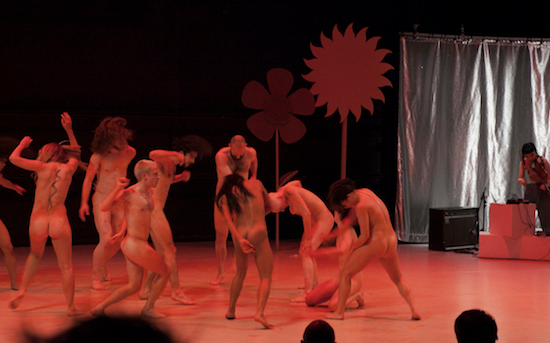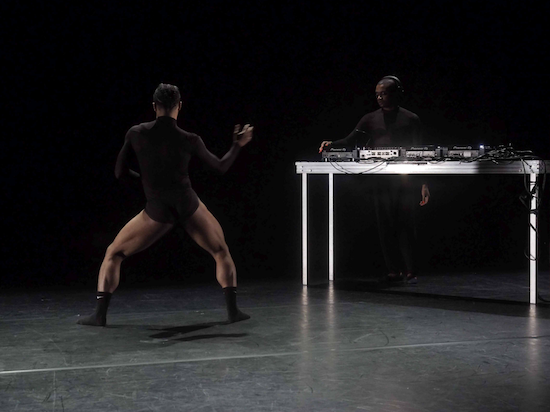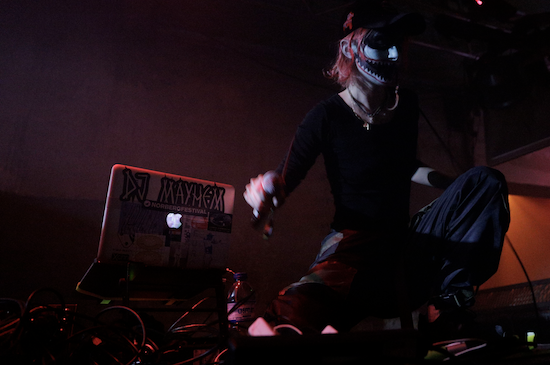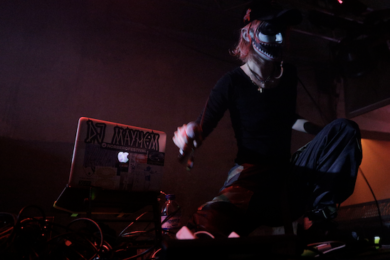HAJ300 [homepage image: Klein]
Everything is uncertain
For many of us, the sense that we’re living through a period of social change and trauma is the new normal. The idea of social upheaval – rather than, let’s say, personal struggle – is a constant presence. Berlin’s ever-ambitious CTM festival tackles this head-on. The festival’s them this year: Turmoil. It’s a striking choice of wording, fostering a sense of chaos, hardship and suffering that ‘disruption’ and ‘disorder’ don’t quite hit. It’s also an artistically fruitful concept, inspiring some artists to seek and spread a sense of comfort to battle our turmoil, while others react violently, or disappear into escapist fantasy worlds. The festival itself is an epic undertaking, lasting over a week and spread all over the city, filling theatres, studios, clubs, concert halls, and of course the power plant of techno itself, Berghain, with myriad nights of perfectly curated experimental gumbos. It’d be a stretch to describe the experience itself as ‘turmoil’, although the bin bags under my eyes and pickled liver I went home with might suggest otherwise.
Besides several nights of hard and heavy electronics, there’s a massive array of sound installations, more conventional gigs, modern dance recitals, and hours of talks, lectures, and discussions. CTM remains a miniaturised crash course in modern underground culture and experimental art, compressing months or even years of experiences into a hyper-intense week. When it comes to the breadth, scope, and consistency of such a festival, CTM is tough to match. It poses questions and answers them all at once, and leaves you with bottomless food for thought. And, yeah, you’ll also have a fantastic few nights out clubbing.
Stopping making sense makes sense
Precisely why we go clubbing, why we hobble around dancing in the dark, voluntarily deaf-dumb-and-blinding ourselves for entire nights in DJs’ hands, can’t just be for cheap kicks. Adrenalin – the gabber and hardcore night held at Berghain on the Friday – makes an amazing case for the art form of clubbing. More than other, headier, more critically accepted dance musics, gabber and hardcore have always been perceived as inherently cheap and intellectually bankrupt. Music for pillheads basically. In the context of this year’s festival, though, the musical aggression and celebration of the bacchanal feels like a real act of defiance. The celebration of excess isn’t dangerous either – it’s hilarious. Some of the DJs in Berghain’s big room wave champagne around, or spin a laugh-out-loud absurd hardcore rework of Carl Orff’s ‘Carmina Burana’, butchering an operatic cantata with stomach-punching kick drum hits that make full use of the club’s legendary capacity for volume. Affiliated with legendary Berlin partymakers Janus, Swedish DJ Kablam is another highlight. Doused in facepaint and flanked by clubbers stripped to their underwear, she grabs a mic and inserts karaoke run-throughs of radio pop-cheese in between ultra-hard dance sessions.
The crowd brought out for the gabber night is exceptional, too. Berlin’s hardly full of normcore kids and suited business people, but the folk stomping their way through hour-long sets of gutpunching hardcore beats in Berghain still stand right out. They variously hint at the club’s roots in a fetish night, donning meagre strips of leather, or they’ve donned garishly emblazoned and brightly coloured gear straight from hardcore’s 90s history. This isn’t your usual Berghain crowd; it’s a grassroots takeover by old-school ravers, marbled in between the club’s usual population of hipster intelligentsia in unquestioning all-black.
The sets themselves create the most enjoyable possible blend of chaos and the absurd. South African producer HDMirror is a highpoint for me, if a slight diversion from the distorted kick drum oof-oof across the night. He triggers crystalline trance music melodies and manic hyperedits, cueing up an impossibly complex amount of high-BPM digital energy, conjoining modern information overload with an Ibiza-era melodic glitz. The whole night somehow manages to be a celebration of Turmoil, and an appeal to stop making sense – which soon strikes me as an appropriate and appealing response to the world at large.

Ernest Berk: Christoph Winkler Company and groupA
We’re already androids
‘Turmoil’ doesn’t just mean a society in the throes of political change, of course; there’s a whole heap of internal and external turmoil going on as we try to adapt to living alongside ubiquitous technologies. Right now I’m staring and typing away at one machine while another burns a radioactive hole in my thigh. Similarly, over the course of a week in Berlin I mostly just watched humans interfacing with machines. Then applauded.
One of the more curious sides of CTM is its series of dance-based performances, this year excellently exploring this human-machine interface. It’s such conceptually fertile ground that even the most boring performance of the festival – Corpus Nil: Eingeweide by Italian performance artist Marco Donnarumma – leaves one with plenty to ponder. The idea is to have Donnarumma wear a robotic arm attached to his back, so an element of his choreography is dictated by the AI that runs the movement of the robotic arm. In reality, it’s overblown and overlong and, worst of all, barely lit. The freak-show excitement of getting to witness a cyborgian dancer is sadly withheld from us; the performance is completed in almost pitch black. Later that evening, a pure and simple meetup between fellow Texans Lotic and Roderick George, the former producing angular technoise from the side of the stage, while the latter performed superhuman feats of (well-lit) dance, is infinitely more riveting.
The dance programme also provides one of the biggest highlights: an evening dedicated to the work of Ernest Berk. The undersung late German choreographer was born in Köln, but fled to Britain in the 30s. The mid-20th century saw Berk pioneer not only new abstract forms of modern dance, but also soundtrack his own pieces with radical electronic techniques akin to the Radiophonic Workshop. For the CTM performance, contemporary choreographer Christoph Winkler’s dance troupe assembled and recreated key pieces from the Berk repertoire, replete with rare digitised versions of Berk’s own original analogue recordings. The music is a uniformly beautiful sort of concrète, blending uncannily industrial electronic whirrs and bleeps with oddball recordings of bashed pans and wood and the odd yearning synth melody. The dancers take us through a series of solos, duets, and, trios, carving abstract new logic right into the air, deploying their bodies like bunraku puppets; serious, bendy, and strange. For the finale the group are joined by Japanese musical duo groupA, who improvise a repetitive backdrop blended with Berk’s music, while the dancers (now all nude) spend a solid half hour escalating improvised motions along the music to ecstatic heights. It’s a recreation of one of Berk’s legendary all-night sessions, wherein dancers and music would cycle on indefinitely experimenting in his Camden studio. But it’s also an alternative history of bodies and machines forming fruitful early networks.
There’s power in numbers
Holly Herndon and her ensemble of healthy youngsters fill up the Festsaal Kreuzberg for a show that’s vaguely similar to the Ernest Berk event. For the first hour, Herndon’s ostensible choir of Berlin-based musicians take it in turns to give solo performances, cabaret-style. They’re dotted around the room, suddenly appearing from the crowd beneath a spotlight with varying success. Ensemble members Albertine Sarges and Marshall Vincent stand out with their distinctly normal (if very high quality) performances of poppy tunes. The best solo shows come from oddball singer-producers Houaïda and Josa Peit, both of whom bump and grind behind samplers from up on balconies overlooking the audience, skewering electronic beats and noisy pop into illogical alien shapes with stellar choruses.
It’s a fitting warmup for the full show with Holly Herndon, Mat Dryhurst and the somewhat grossly ponytailed Colin Self entering the stage. Herndon’s knack for writing a good tune has always been merely the bedrock of a music aiming to explore sonic fringes and deeper concepts. So this rebranding of the project as a kind of yoga-techno company isn’t entirely surprising. The choir walk on stage in draped in matching Daz advert white clothes. They actually add very little to the more standard Herndon future-pop tunes in the set; those based around verses, choruses and fractured beats. But they prove indispensable during the many interludes and preludes between tunes. At times they go off mic, conjuring emotive group blasts of a cappella melody.
Herndon conversely performs several interludes of live-processed vocalisations solo, which are arguably even more compelling. I’m left vaguely frustrated by the performance, mainly as the highs feel let down by the lows. It’s a complicated mess of half a dozen vocalists, live vocal processing, a manic lightshow, dance moves and plenty of additional theatrics – you’ve definitely got to admire the ambition. The ensemble periodically descend into chaos, and their matching outfits are a tad absurd (think a revival of Hair, sponsored by Dove soap), yet the overall result is so full of vision, it leaves Herndon in the black. The message is simple: working together is great. It’s certainly gonna help us sort out this global bloody mess we’re all in.

Lotic and Roderick George
Musicians need not be sentient
Besides the performance programme, CTM always holds a magnificent array of Q&As, discussions, and lectures with artists and industry personnel. It’s the kind of thing a slightly younger incarnation of me would roll my eyes at, yet I now find myself happily clambering out of bed mid-morning, half-dead and bearing a headache the size of Wales, ears still ringing from a day’s worth of festivalling, to go watch a lecture. My student self wouldn’t believe it.
Yet when Jace Clayton is giving a talk, you really have to be there. The man also known as DJ /rupture has been making his rounds on the scene of late. He’s been performing a revived version of his 2013 Julius Eastman Memorial Dinner performance for two pianists plus effects and projections, ever since the titular deceased minimalist composer finally entered general consciousness in 2016. Besides the musical performance, Clayton gives a talk based around his new book, Uproot: Travels in 21st-century Music & Digital Culture; he makes a solid argument that turmoil and chance gives rise to musical invention, and that music and sound can also help us to articulate such upheaval. He spins through familiar material during his lecture – Cher’s video for ‘Believe’ which pioneered autotune in 1998 by abusing the effect, or Hendrix deconstructing ‘The Star-Spangled Banner’ at Woodstock – but always finds a unique spin on how the music can capture, express and define change. Memorably, Clayton uses a clip from relatively forgotten 2001 comedy movie Pootie Tang, wherein the titular singer performs a song without any words or sounds to express the capacity machines have to capture musical spirits like a Ghostbusters ghost trap. Clayton himself is just too damn smart, funny, and charming – I honestly wish the talk was longer.
Against all our sleeping patterns, the daytime talks go on throughout the week. The DJs from the hardcore and gabber night assemble for a panel one afternoon, while a barbed discussion about the treatment of women in the music industry searches for answers on another. The best lecture of all comes from American free-jazz trombonist and composer George E Lewis. He focuses on his decades of work creating interactive computer-musicians to improvise with. He goes into detail about a lengthy string of intriguing computer systems he built to interact with human musicians, including ‘Rainbow’ from the early 80s and his ‘Voyager’ programme, which he used to control a piano alongside sax player Roscoe Mitchell only the night before.
Lewis’ work calls into question so much about the nature of artificial intelligence, yet more breathtaking are the ways it reveals improvisation as being itself codified (and thus programmable). He reveals something far deeper, something about humans. To what extent is behaviour even voluntary? By which standards is improvisation an organic act dictated by a mixture of entropy and will rather than a farcical interaction with musical syntax?
You can build your own escape route
Reflecting on a week spent cycling the German capital to chase the overflowing CTM lineup (to which there’s nowhere near enough space to do justice in a single review), there’s many familiar conclusions to be drawn. Firstly, we are indeed living in exceptional times. Not only are things a bit politically cataclysmic right now shall we say, but this is a golden age for music and art. Commercialism’s ugly head was nowhere to be seen throughout CTM. Neither was cynicism, for that matter (at least it left my cynical damn head for a few quick days). Our ability for thoughtful and original expression is at an all-time peak – and it’s thanks to our old buddy technology. It’s perhaps often too tempting to blame this state of turmoil on technology, rather than view it as a possible saviour. A couple of decades of high-speed mobile communication, and the world’s gone to shit in an information overload shower of racist memes and misspelled tweets? I disagree.
Some distance into East Berlin, a so-called 4DSOUND system at Berlin’s Center for Spatial Sound is deployed for several performances, including one by London experimentalist Gaika. He stands in the centre of a the space, behind a laptop and pedal setup from which he spins inverted R&B tunes, cosmic drones, and spacious beats that bounce around inside the nimble multi-channel space. The content of the performance is a kind of autotune space opera, where Gaika makes a political stand for ownership of the city and seems freed by futuristic technology.
A few nights prior, the awesome jet-engine electronics of German sound artist Marcus Schmickler aims just as high into the stratosphere. Guided across Berghain’s awe-inspiring sound system in gradual ear-piercing waves, it feels almost like weaponised sound. Another Londoner pulls a similar trick – Klein plugs her meagre Windows laptop into the Berghain mixing desk and turns it into a rocket-ship noise machine. Perhaps machines define our current turmoil – but they also enable us to craft new universes. With them, we can plot our escape route.



